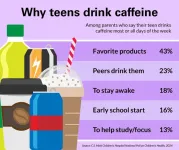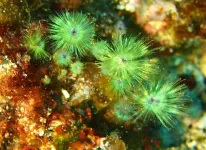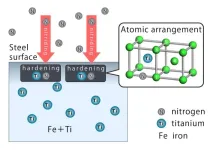(Press-News.org) Researchers at Karolinska Institutet in Sweden have succeeded in delivering targeted cancer treatment via small membrane bubbles that our cells use to communicate. A new study published in Nature Biomedical Engineering shows that the treatment reduces tumour growth and improves survival in mice.
When our cells communicate, they send out small membrane bubbles known as extracellular vesicles which contain various signalling molecules. Interest in these tiny bubbles, sometimes referred to as the body’s ‘message in a bottle’, has increased in recent years as they could be used to deliver medicines.
Antibodies seek out tumours
Researchers at Karolinska Institutet have now created a targeted cancer treatment by loading these bubbles with a chemotherapeutic drug and attaching antibodies against tumours to their surface. In addition to targeting tumour cells, the antibodies act as a form of immunotherapy, resulting in an enhanced therapeutic effect. The treatment reduced tumour growth and improved survival when given as an injection to mice with breast cancer or melanoma.
“By attaching different antibodies to extracellular vesicles, we can target them to virtually any tissue and we can load them with other types of drugs as well,” says Oscar Wiklander, physician and researcher at the Department of Laboratory Medicine, Karolinska Institutet, and joint first author with Doste Mamand, researcher at the same department. “Therefore, the treatment has the potential to be used against other diseases and cancer types.”
More effective and fewer side effects
The hope is that the new treatment will be more specific and effective in eliminating tumour cells without affecting healthy tissue, compared to current treatment strategies. The researchers plan to investigate whether different combinations of antibodies and drugs can further improve treatment.
“Among other things, we want to investigate the possibility of delivering mRNA as an anticancer drug,” says the study’s last author Samir EL Andaloussi, Professor at the Department of Laboratory Medicine, Karolinska Institutet. “Ultimately, we hope this can lead to a new treatment platform that can improve treatment efficacy and reduce side effects in difficult-to-treat diseases, especially cancer.”
The research was mainly funded by the Swedish Cancer Society, the Swedish Research Council, the European Research Council (ERC) and CIMED. Several of the authors have a financial interest in Evox Therapeutics.
Publication: ”Antibody-displaying extracellular vesicles for targeted cancer therapy”, Oscar P. B. Wiklander, Doste R. Mamand, Dara K. Mohammad, Wenyi Zheng, Rim Jawad Wiklander, Taras Sych, Antje M. Zickler, Xiuming Liang, Heena Sharma, Andrea Lavado, Jeremy Bost, Samantha Roudi, Giulia Corso, Angus J. Lennaárd, Manuchehr Abedi-Valugerdi, Imre Mäger, Evren Alici, Erdinc Sezgin, Joel Z. Nordin, Dhanu Gupta, André Görgens, Samir EL Andaloussi, Nature Biomedical Engineering, online 20 May 2024, doi: 10.1038/s41551-024-01214-6.
END
Body’s ‘message in a bottle’ delivers targeted cancer treatment
2024-05-20
ELSE PRESS RELEASES FROM THIS DATE:
1 in 4 parents say their teen consumes caffeine daily or nearly every day
2024-05-20
ANN ARBOR, Mich. – A quarter of parents report that caffeine is basically part of their teen’s daily life, according to a national poll.
Two in three parents think they know whether their teen’s caffeine intake is appropriate and which products have too much caffeine. Yet a third aren’t able to identify recommended caffeine limits, according to the University of Michigan Health C.S. Mott Children’s Hospital National Poll on Children’s Health.
“Our report suggests parents may not always be aware of how much they should be limiting caffeine consumption for teens,” said poll co-director and Mott ...
What makes some brown algae shimmer and others not?
2024-05-20
Compartments of consistently sized, tightly packed microspheres are what makes some brown algae shimmer like opal. The Kobe University discovery not only sheds light on the mechanism behind the alga’s structural coloration, it is also the first to spot the effect in an order of brown algae other than the two where it was known to occur.
Most brown algae are indeed yellowish-brown, but scuba divers noticed that a species resembling Sporochnus in the order Sporochnales shimmers like peacock feathers in yellow, ...
Seeking stronger steel, systematic look at 120 combinations of alloy elements provides clues
2024-05-20
Decarbonization of automobiles not only requires a shift from gasoline engines to electric motors, but also quality steel parts that help the motors run while lessening the weight of vehicles. High-performance steel materials can offer quieter rides and resist the wear and tear from high-speed rotation in motors. To create them, the process of modifying the steel surface with carbon, nitrogen, and alloy elements needs to be optimized.
To understand the interactions between elements in steel, a systematic investigation ...
Tricking the Brain’s inner GPS: Grid cells responses to the illusion of self-location
2024-05-20
Dr. Hyuk-June Moon from the Bionics Research Center at the Korea Institute of Science and Technology (KIST), in collaboration with Prof. Olaf Blanke’s team at the Swiss Federal Institute of Technology Lausanne (EPFL), has successfully induced self-location illusions with multi-sensory virtual reality (VR) in the MRI scanner and observed corresponding changes in the human brain's grid cell activity.
The brain is known to contain grid cells and place cells, which perform global positioning system (GPS) functions that allow us to recognize where we are. While ...
Gallbladder cancer rises among Black Americans as cases decline in other groups
2024-05-20
WASHINGTON, DC (May 20, 2024) — Gallbladder cancer rates have been stable or declining for most Americans over the last two decades, but cases have steadily risen among Blacks, with growing numbers not being diagnosed until later stages, according to a study scheduled for presentation at Digestive Disease Week® (DDW) 2024.
“Gallbladder cancer diagnosis at late stage can be highly detrimental,” said lead author Yazan Abboud, MD, internal medicine resident at Rutgers University New Jersey Medical School. “This could be due to a lack of timely ...
Biomarker for gastric cancer and other cancer studies set for digestive disease week
2024-05-20
Washington (May 14, 2024) — Cancer-related studies, including a diagnostic tool for gastric cancer and trends in gallbladder and colorectal cancers, will be presented this week at Digestive Disease Week (DDW) 2024. Abstracts are available to registered media, and press releases are available where noted. Studies are embargoed until 12:01 a.m. EDT the day of presentation, unless otherwise noted.
Here are summaries of the new research on the schedule:
Oral microbiome signatures as potential biomarkers for gastric cancer risk assessment, Abstract 949, will be presented Monday, May 20, at 4:15 p.m. EDT. (A press release is available upon request. Embargoed until 12:01 a.m. EDT ...
Endoscopic studies presented at Digestive Disease Week
2024-05-20
Washington (May 14, 2024) — Studies featuring endoscopic and laparoscopic procedures, including patient views on artificial intelligence in endoscopy and hazards to healthcare personnel of smoke-producing procedures, will be presented this week at Digestive Disease Week (DDW) 2024. Abstracts are available to registered media, and press releases are available where noted. Research is embargoed until 12:01 a.m. EDT the day of presentation, unless otherwise noted.
Here are summaries of the new research:
Patients’ sentiments ...
Hunger hormone, antibiotic-induced weight gain, and sleep and digestive health explored at Digestive Disease Week
2024-05-20
Washington (May 14, 2024) — Studies exploring the hunger hormone, weight-loss drugs, sauerkraut and antibiotic weight gain, the impact of physician gender on care, and the relationship between sleep patterns and digestive diseases will be presented this week at Digestive Disease Week (DDW) 2024. Abstracts are available to registered media. Embargos lift at 12:01 a.m. EDT on the day they are presented unless otherwise noted.
Here are summaries of the new research:
Performance of a machine-learning gene ...
Innovative 3D printing could revolutionise treatment for cataracts and other eye conditions
2024-05-20
Peer-reviewed – Proof-of-concept study
University of East Anglia researchers have made a significant breakthrough in ocular device technology with the introduction of a novel resin for 3D printing intraocular devices. This innovation has potential to enhance the manufacture of eye implants universally used in cataract and refractive surgeries.
An artificial intraocular lens (IOL) is primarily required for people with cataracts, a condition where the eye’s natural lens becomes cloudy, obscuring vision.
They can also be also used to correct refractive errors such as myopia (nearsightedness), ...
Rigid approach to teaching phonics is ‘joyless’ and is failing children, experts warn
2024-05-20
Experts have released robust research to show that phonics should be taught hand-in-hand with reading and writing to encourage true literacy and a love of reading, not through narrow synthetic phonics.
There is widespread disagreement globally across academic and educational spheres about the best way to teach children to learn to read and write. Despite a growing international trend towards a narrow approach to synthetic phonics, experts suggest there is a ‘better way’ to teach reading and writing.
In England, the system is among the most prescriptive in the world with ‘synthetic phonics’ being the ...



